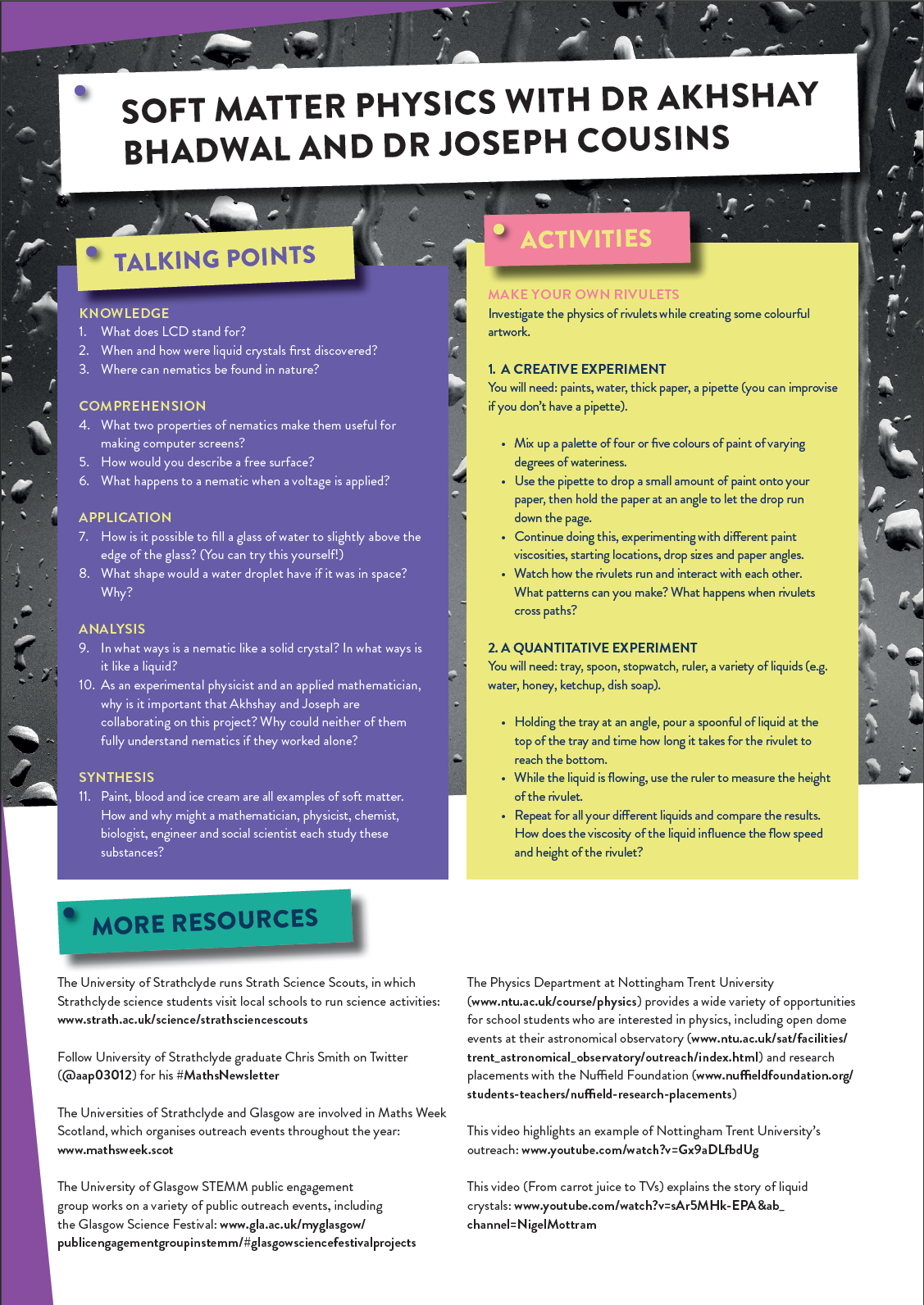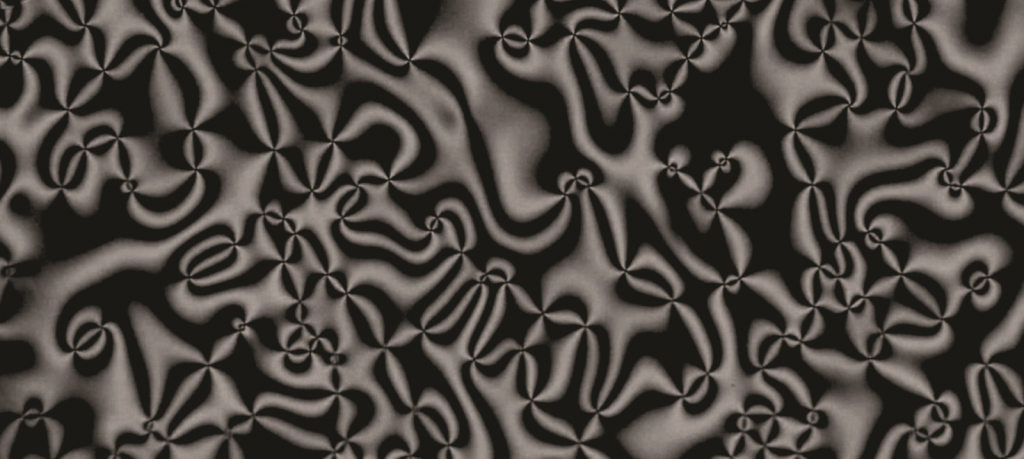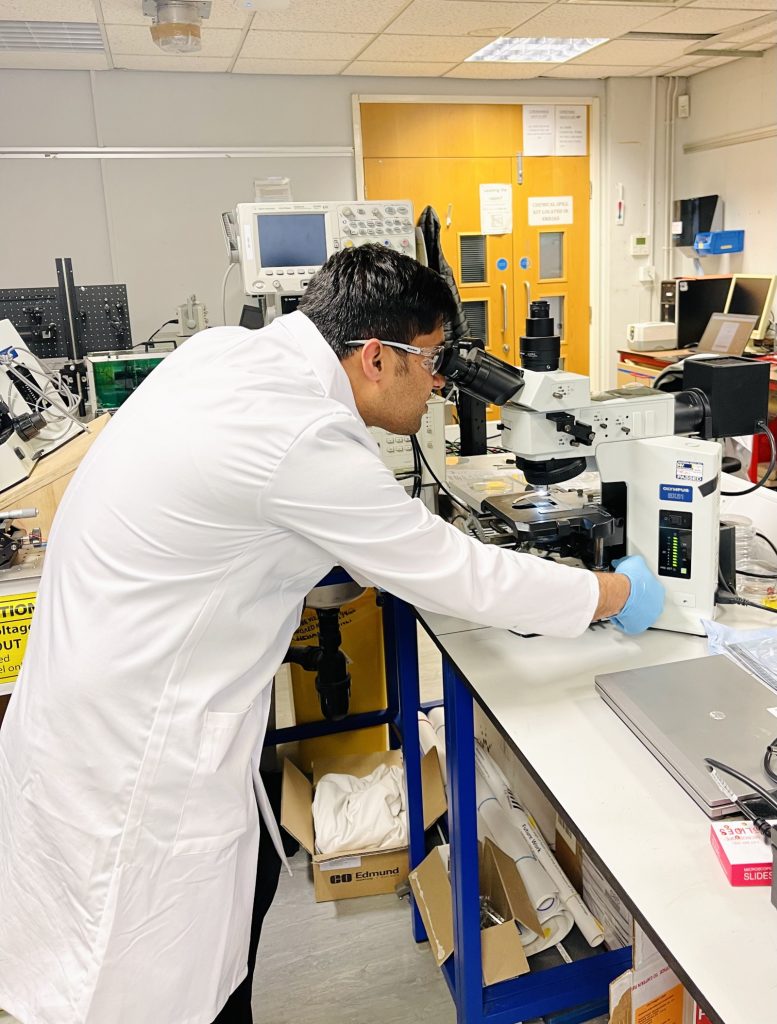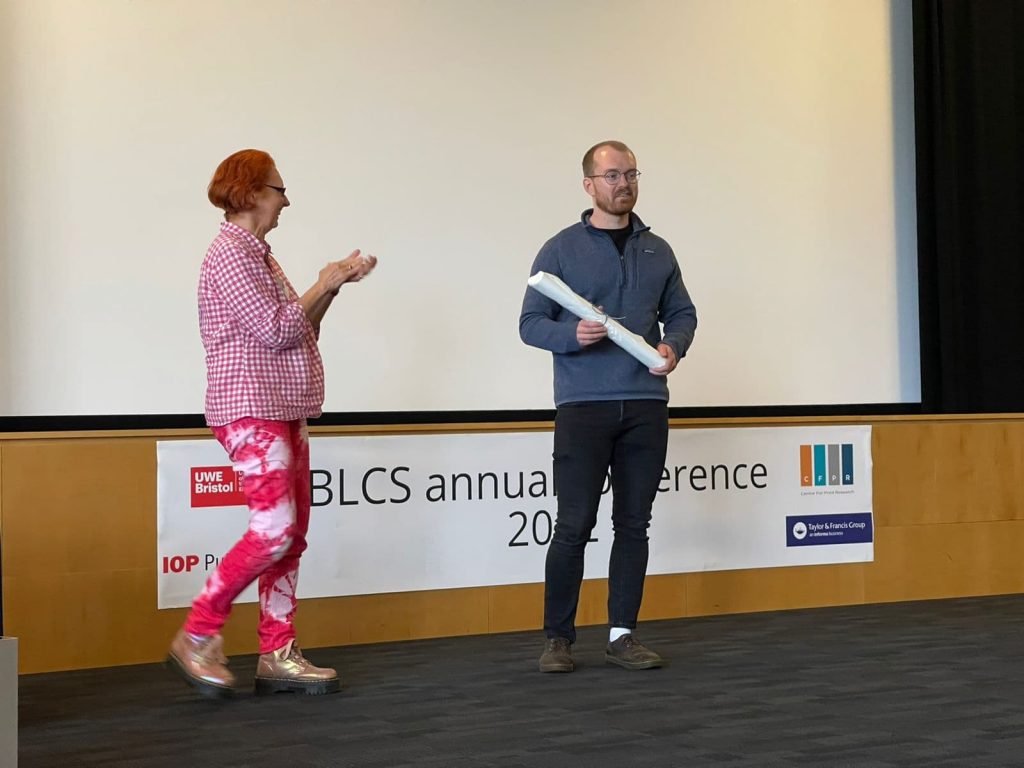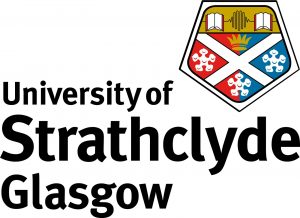Behind the screens: the crystals that flow like rain down a windowpane
CRYSTAL – a solid material with a high degree of internal ordering of its molecules
FLUID – a material that flows and changes shape when a force is applied to it, including liquids and gases
LIQUID CRYSTAL – a material that flows like a liquid but has some properties of crystals
NEMATIC – a type of liquid crystal, in which molecules tend to align with each other
POLARISATION – the orientation of a light wave, a property used in technology to control light
VISCOSITY – a measure of a fluid’s internal friction, a property perceived as the fluid’s ‘thickness’ or ‘stickiness’. Viscous fluids are sticky and flow slowly while less viscous fluids are runny and flow quickly

When was the last time you looked at a computer, TV, phone or tablet? Perhaps you are reading from one now. If so, you are almost certainly using a liquid crystal display (LCD). While you may have heard the term LCD before, have you ever wondered how they function?
Dr Akhshay Bhadwal is an experimental physicist at Nottingham Trent University, and his job is to explore how LCDs function by conducting experiments with liquid crystals. Helping him to understand the results is Dr Joseph Cousins, a mathematician at the Universities of Glasgow and Strathclyde. Together, they are investigating a certain type of liquid crystal, known as a nematic.
WHAT ARE NEMATICS?
In 1888, Friedrich Reinitzer, an Austrian scientist, was experimenting with a chemical he had extracted from carrots when he found something strange. As he heated the chemical, it initially converted into a cloudy liquid. On further heating, this cloudy liquid became clear. In the cloudy liquid phase, he had accidentally discovered liquid crystals – materials that flow like liquids but have some properties of crystals.
Since then, scientists have discovered many different phases of liquid crystals. One of the most important phases is the nematic phase, which has a thread-like texture when observed under a polarised light microscope. Unlike solid materials, in which molecules are fixed in position, molecules are free to move in the nematic phase, but, on average, point in a preferred direction that aligns with the other molecules (see diagram above). This average alignment gives nematics some properties of crystals, while the freedom molecules have to move gives them some properties of liquids.
HOW CAN WE USE NEMATICS?
The orientation-dependent properties of nematics give them two special features that are useful for LCDs. Firstly, the molecular structure can change the polarisation of light. Secondly, the way the molecules align can be changed by applying a voltage across the nematic. The LCD in your phone works by controlling the voltage applied to the nematic, which alters the polarisation of the light passing through different parts of the display. This control allows the creation of an image on the screen.
As well as being used in technology, nematics are also found in nature. The cytoplasm in living cells has a nematic state and a spider’s silk is nematic before it solidifies.
WHAT ARE FREE SURFACES?
Boundaries between two fluids (for example water and air) are known as free surfaces, and they are found wherever two fluids meet. “For small volumes of fluid, the shape of these free surfaces is typically determined by surface tension, which arises from the cohesion of molecules on the free surface,” explains Joseph. “For larger volumes of fluid, gravity also becomes important.”
In general, surface tension acts to minimise the surface area of the free surface. Mathematically, a sphere is the shape that minimises the surface area of a fixed volume, explaining why small water droplets on a flat surface take the shape of a spherical cap. But, when enough water droplets collect to form a puddle, the effects of gravity take over, giving the puddle a flat free surface.
Akhshay and Joseph have been studying the free surfaces of nematics. Here, as well as surface tension and gravity, the orientation of the molecules also comes into play. Because applying a voltage changes the orientation of the molecules, this can be used to change the shape of the nematic free surface.
AKHSHAY’S PHYSICAL EXPERIMENTS
Akhshay has been watching how nematics flow down a sloped pane of conductive glass in thin streams called rivulets. If you look out the window on a rainy day, you can see for yourself how raindrops form rivulets when they slide down the glass. In Akhshay’s experiments, he can control exactly where the rivulet forms and the speed at which it flows, and he can also apply a voltage across the glass. He then uses cameras and microscopes to measure the height of the rivulet free surface under different flow speeds and voltage conditions.
The experiments have shown that the free surface of a nematic can be controlled by the applied voltage. “When molecules align along the direction of flow, the nematic is less viscous,” says Akhshay. “However, as you increase the voltage, molecules increasingly align along the electric field and the liquid becomes more viscous. As a result, the flow slows down and the height of the rivulet free surface increases.”
JOSEPH’S MATHEMATICAL MODELS
Reference
https://doi.org/10.33424/FUTURUM287
While the experimental results show how nematics behave, the next step is to develop a mathematical description of what is happening. This not only helps scientists understand what is going on behind the scenes, and why, but also helps to enable the physics to be applied in technology in the future. For example, as Akhshay can control a rivulet by applying a voltage, he might want an equation to estimate how much the height of the free surface will change for a given change in voltage.
This is where Joseph comes in. He starts by considering some basic principles of physics – that the momentum and energy of a system are always conserved. “The problem is that considering every possible effect that contributes to momentum or energy is complicated,” he explains. The results of Akhshay’s experiments, however, help to show Joseph which are the important factors. He uses these key factors to construct mathematical models that capture the key physical effects of nematic behaviour.
COMBINING EXPERIMENTS AND MATHEMATICAL MODELS
Joseph builds mathematical models based on the key aspects of the system, then uses them to predict what will happen when Akhshay changes a variable in the physical experiment. Akhshay then conducts that experiment, and they compare their results.
“We compare the measured experimental value with the value calculated from the model to check how well our theoretical model predicts the experimental outcome,” explains Akhshay. “Once the models and experiments agree with each other, we can then use the model to determine other parameters which can’t be found experimentally.”
In this way, the physical experiments and mathematical models work together to deepen our understanding of nematics. As liquid crystals are a key feature of many modern technologies, Akhshay and Joseph’s discoveries are likely to contribute to important technological advances in the future.

DR AKHSHAY BHADWAL
School of Science and Technology
Nottingham Trent University, UK
FIELD OF RESEARCH
Experimental Physics

DR JOSEPH COUSINS
Department of Mathematics and Statistics, University of Strathclyde, UK
School of Mathematics and Statistics, University of Glasgow, UK
FIELD OF RESEARCH
Applied Mathematics
RESEARCH PROJECT
Control of free-surface flow morphologies in anisotropic liquids (Grant numbers EP/T012986/1 and EP/T012501/2)
FUNDER
Engineering and Physical Sciences Research Council (EPSRC)
Soft matter (which includes just about anything squishy) is fascinating at the molecular level because it includes both elements of order and disorder. The realm of soft matter physics investigates materials that lie between ordered solids and disordered liquids. To picture this, imagine people were molecules. A solid would look like a parading army, with every soldier perfectly in line, and a liquid would be a city centre where everybody is going their own way and doing their own thing. Soft matter is more like a party – most people are split up into groups, but the groups can change or merge into each other.
The fun thing about a party is that a small change in conditions (perhaps a new song starts to play) can cause a sudden and dramatic change in the people (everybody gets up onto the dancefloor). The same is true of soft matter, and this is one reason that physicists are fascinated by it. For example, a small change in voltage across a nematic can transform its optical properties.
WHERE CAN YOU SEE SOFT MATTER PHYSICS IN ACTION?
The molecules in soft matter sometimes seem to take on a life of their own. Under the right conditions, they can combine to create complex structures, and life could not exist without this phenomenon. Because of this, soft matter physics is often seen as the ‘physics of life’, and the quickest way to see it in action is to take a look in the mirror and smile. The protein powering your muscles as you smile works using soft matter physics!
Other natural and artificial examples of soft matter include gels, paints, soap, blood, cosmetics and ice cream. These materials are studied by scientists from various disciplines, including mathematicians, physicists, chemists, biologists and engineers, highlighting the many different routes into the field of soft matter physics.
EXPLORE CAREERS IN PHYSICS AND MATHEMATICS
• From climate science and healthcare to business and robotics, a degree in physics can take you just about anywhere. Find out more about physics career paths at the Institute of Physics.
• Not sure if attending university is for you? There are plenty of other ways to start your career in physics. Learn more about apprenticeships and vocational roles at the Institute of Physics.
• Applied mathematicians also work in a wide range of well-paid jobs. “Even if you don’t end up working in research, a mathematics degree is a fantastic asset for working in so many industries, including finance and engineering,” says Joseph. See the Institute of Mathematics and its Applications website to find out where a maths degree could take you.
PATHWAY FROM SCHOOL TO PHYSICS OR MATHEMATICS
• Studying maths and physics at school will enable you to study maths or physics at university. If you are interested in soft matter, it would also be good to study another science, such as chemistry or biology.
• Building mathematical models and analysing physical experiments require coding skills, so computer studies may also be useful.
• Most universities offer undergraduate degrees in physics or mathematics, or joint degrees in both subjects. Some may offer specific degrees in experimental physics and/or applied mathematics, though these may be at the postgraduate level.
• To work in academia, you will need to complete a PhD, but physics and mathematics skills and knowledge are also important for many other research jobs and careers in industry.
I had a lot of different interests when I was younger, but none of them was science! That was until I performed some zoology experiments with my dad in our home lab. It was surprising for me to see how some species can regrow missing parts within days.
I love the wide applicability of physics. Everything in natural science can be reduced to physics. Isn’t it cool that by understanding physics, you can know the past, present and future of a system? I think you are always a physicist, whatever field of science you work in.
Experimental physics is all about understanding and observing the mysteries of nature. These mysteries are coded in the language of nature – maths. As an experimental physicist, I can observe phenomena, but to decipher them I need mathematical models. This is why our collaboration, between physicist and mathematician, is crucial for unravelling how physical systems behave. Physicists focus on observing the effect, then mathematicians help to answer why the effect is happening.
The most rewarding part of my job is being in the lab. It’s amazing to see the science right in front of your eyes. I also like being a scientist because every working day is different, it’s not a monotonous 9-to-5 job – it’s full of fun! The most challenging part of my work is turning ideas into real physical experiments.
Throughout my academic journey, I have been fortunate to receive many scholarships to support my research. I don’t have a defined long-term ambition. I like doing science and so want to pursue this for my lifetime. I hope to be remembered for my work.
Outside of work I enjoy travelling and exploring different places. Apart from this, I like watching historical series and playing games.
1. Learn by doing. It’s good to have formal education in a specialist field of science, but it’s not a necessity.
2. Hunt around for different courses by talking to teachers and students to figure out what interests you.
3. Be curious and enjoy science.
I had various interests while at school, mainly football and computer gaming. I don’t think science and mathematics became an interest until I approached my exams when I was 16. It was around that point I started to realise I enjoyed these subjects. Exams in these subjects made me feel competitive in the same way that football and computer gaming always had.
My dad gave me a book by the travel writer Bill Bryson called A Short History of Nearly Everything, and I remember being amazed by the explanations of the big bang and the atom. This book left me wanting to learn more about physics, so I kept reading. I read A Brief History of Time by Stephen Hawking and Physics of the Impossible by Michio Kaku. Ultimately, it was these books that inspired me to study physics at university. Studying physics then showed me that to understand physics, you must understand maths. So really, physics inspired me to become a mathematician.
The most rewarding part of being a mathematician is getting an insight into how the world works. With a pen, a pad of paper and a computer, I can unravel how a physical system behaves with the tools that mathematics provides. I think it’s satisfying and a great privilege to have the skills to understand and discover how the world works.
The most challenging part of being a mathematician isn’t the maths, it’s the writing! Communicating scientific research is a really hard skill. It requires skills that don’t always come naturally to mathematicians.
The highlights of my career were completing my PhD and receiving the British Liquid Crystal Society Young Scientist Award. These achievements are a great reminder of what I have contributed to my field. I don’t have too many ambitions for the future. I’d like to be happy and work on science that interests me, but that’s all I’m sure of.
Out of work, I spend time with my girlfriend and our golden retriever, Hugo. I still find some time to play computer games and follow football.
1. Read popular non-fiction books in areas you enjoy at school. This is a great way to get interested in science.
2. If you want to learn more, explore the resources provided by official bodies such as the Institute of Physics or the Institute of Mathematics and its Applications.
Write it in the comments box below and they will get back to you. (Remember, researchers are very busy people, so you may have to wait a few days.)


